St. Paul’s Cathedral – The Best View in London
Despite being a fairly frequent visitor to London, up until my last visit I had never been inside St Paul’s Cathedral. Arguably the most iconic London landmark after the clock tower which holds Big Ben, St. Paul’s Cathedral is visible from many vantage points along the Thames. However, in terms of visitors it has always played second fiddle to the older and more storied Westminster Abbey, which was over seven hundreds years old at the time of the Great Fire of London in 1666.
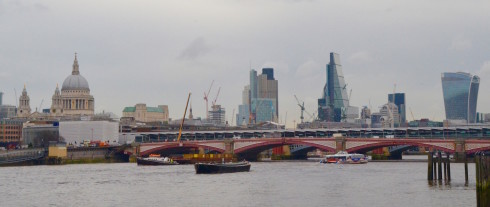
History of St. Paul’s Cathedral
The Great Fire was the greatest urban renewal project in modern history with almost 80% of London destroyed including the gothic St. Paul’s Cathedral which had stood on the site since 1240. The old cathedral featured a prominent spire that marked it as the tallest building ever erected in its time. It collapsed in 1561 after being hit by lightning. Old St. Paul’s Cathedral was the scene of the funerals of Richard II, Henry V and Henry VI. It was also where Henry VII’s oldest son Arthur (yes there was supposed to be a real King Arthur) married Katherine of Aragon. After he died Henry VIII took his place and we all know how that turned out. English translations of the Bible by William Tyndale were burned in old St. Paul’s so it’s pretty ironic that one of the three surviving copies is today housed in St Paul’s Cathedral. The great poet and religious scholar John Donne (No man is an island) was dean of St. Paul’s for the last decade of his life and was buried there along with the famous Dutch painter Anthony van Dyck.
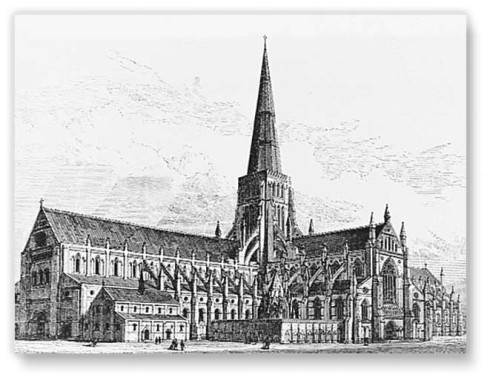
Within five years of the fire over 9,000 new buildings were erected in London and work commenced on some of Christopher Wren’s amazing collection of churches. Wren was recognized as the greatest architect of his time and had been commissioned to build a dome over old St. Paul’s just a week before the fire. After the fire it took him nine years to fully develop the plans for the new St Paul’s Cathedral for which Wren relied heavily on the architecture of Italian domed churches that he had visited before the fire. Work commenced in 1675 and was finished by 1708. Wren lived to see his greatest work completed and is now buried in the crypt where this famous line is found, “If you seek his monument, look around you.”
As early as 1715 the crypt began to attract the rich and famous as a final resting place and today only Westminster Abbey can compete with so many famous deceased souls. More about them when we visit the crypt. In 1790 the tradition began of memorializing great men, and later women, with monuments in St. Paul’s. The first was to the great prison reformer John Howard.
During the WWII blitz, St Paul’s Cathedral became a symbol of British defiance and stalwartness as daily services were held as the RAF battled the Luftwaffe overhead. That event is commemorated in this 1965 stamp. It always struck as really ballsy of the Brits, having invented the postage stamp, never to actually put the name of their country on them.
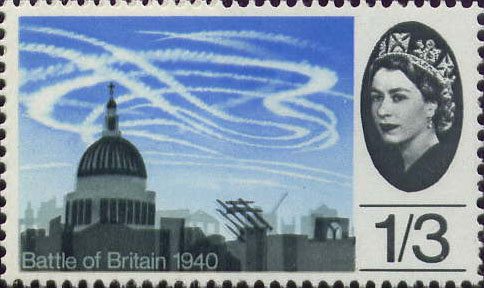
This photograph of St. Paul’s during the blitz may be the most famous of the time.
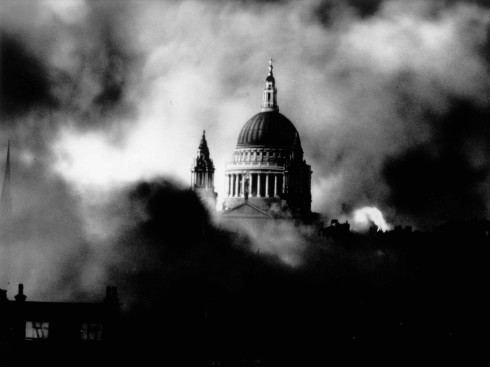
After the war the funerals of Winston Churchill in 1965 and the Iron Lady, Margaret Thatcher in 2013, were held at St. Paul’s. So I have definitely been remiss in not getting to this venerable place before now.
Visiting St. Paul’s Cathedral
There are a number of ways to approach St. Paul’s, but I have to think the best is by crossing the Millennium Bridge which is a steel suspension bridge for pedestrians only that looks like it is aligned directly with the dome of St Paul’s Cathedral. That’s my daughter Lenore on the left as we prepare to cross the Thames heading for St Paul’s Cathedral.
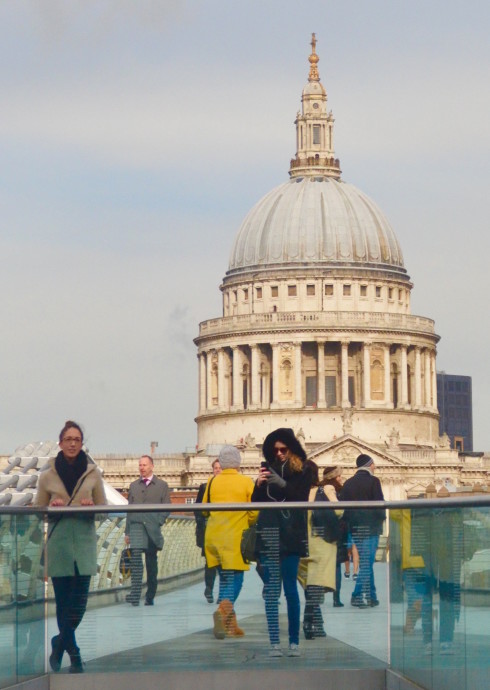
And here’s what it looks like from the other side of the bridge.
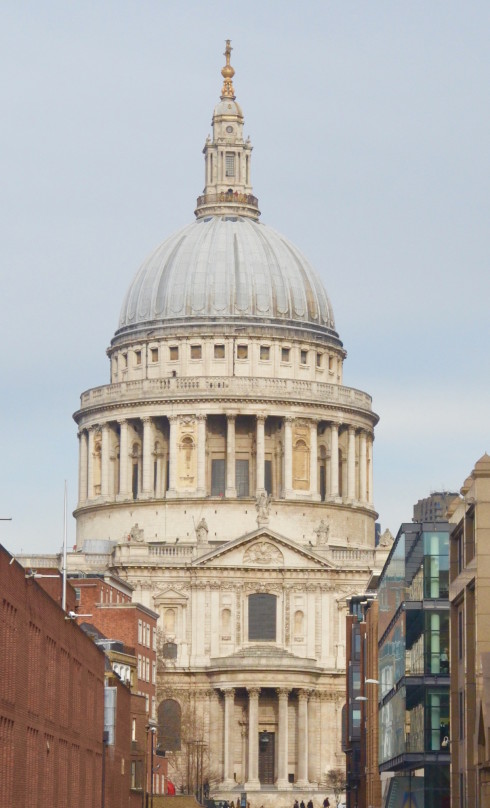
Entrance to St. Paul’s Cathedral is £17.00 which is pretty steep by church entry standards, but it does include a multi-media guide or a guided tour if you want to go in a group. You can buy tickets online here. No photography of any kind is allowed inside so you’ll have to put up with a thousand words instead – just kidding! Here’s the floor plan which follows the traditional cross shape of most cathedrals. The immense dome rises exactly from the nave where the transepts flank it on each side.
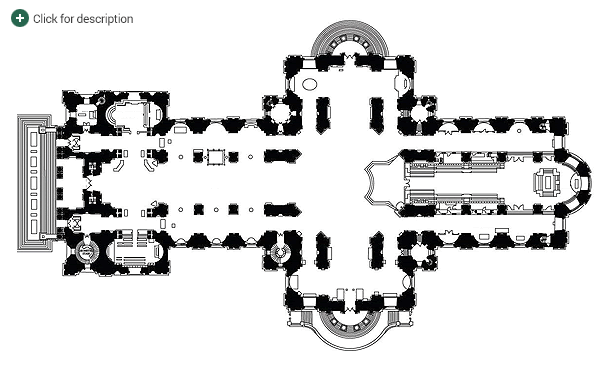
If you’ve visited Westminster Abbey the first thing you’ll notice about St Paul’s Cathedral is that it’s way more airy, much bigger and there will only be a fraction of the number of visitors. Touring Westminster Abbey can seem almost claustrophobic at times, especially the Henry VII Chapel, while St. Paul’s is the opposite. Lenore and I were to take our time and take in the multi-media tour without being jostled or thronged. By far the most impressive site inside St. Paul’s Cathedral is looking up at the dome. Stare at it long enough and you almost get vertigo.
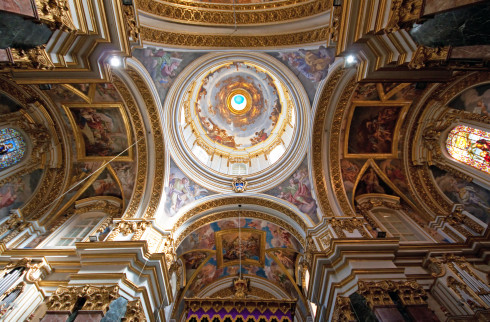
The Crypt
The crypt of St. Paul’s Cathedral was to me, at least as interesting as the main floor. Unlike Westminster Abbey where the tombs are at ground level or under the main floor, here there is an honest to goodness crypt with all the creepiness that that usually implies. Except it’s not creepy because it’s pretty well lit, the sarcophagi are quite grand and there are no bats flying around. While Westminster Abbey has its Poet’s Corner, St. Paul’s Cathedral seems to specialize in martial figures and there are none more famous than Lord Nelson and the Duke of Wellington.
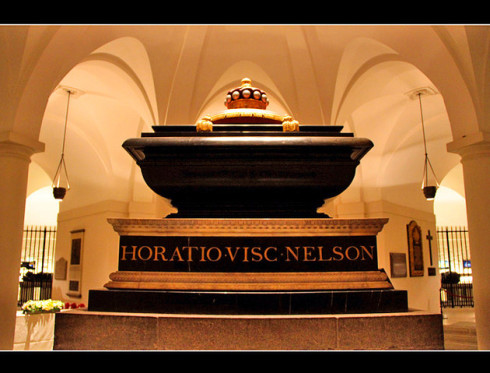
This tomb of Lord Nelson’s was originally meant for Cardinal Wolsey who died way back in 1530, but never used as he died in disgrace, stripped of his many offices at the urgings of Anne Boleyn.
Wellington, who outlived Nelson by almost fifty years, had a funereal procession and funeral that was reputed to be the largest in British history. By the time Churchill died fire regulations wouldn’t let that many people crowd in as they did in this picture.
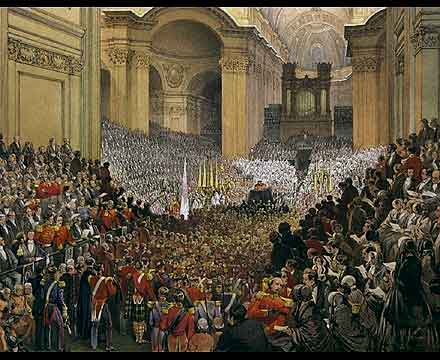
As a devotee of Richard Sharpe, Harry Flashman and Jack Aubrey, I not only know of Nelson and Wellington, but of dozens of other British military greats and not-so-greats that are buried or memorialized in the crypt. One of the not-so-greats is Charles Cornwallis who has the dubious distinction of surrendering to George Washington at Yorktown and ending the American Revolution in defeat for the British. One of the greats is Sir Garnet Wolseley who served in the Crimean War, relieved Lucknow in the Indian mutiny and most famously (or infamously depending on your point of view) put down Louis Riel’s 1870 Red River rebellion. There’s still a major street in Winnipeg named for him.
Wolseley is not the only Canadian connection in the St Paul’s Cathedral. Here you’ll find American artist Benjamin West who painted one of the most famous paintings in Canadian history, The Death of General Wolfe. Every school kid in Canada my age remembers this from our history lessons. I’ve always wondered what the aboriginal figure in the left foreground is meant to be thinking, he’s such a calm contrast to the obvious panic on the faces of the others.

Also in the crypt is Sir George Williams who founded the Y.M.C.A. in London and then after opening the first one in North America in Montreal got a university named after himself there. There was a famous student riot/peaceful protest (take your pick) there in 1969. It’s now called Concordia.
The last Canadian connection was totally unexpected. A bust of Sir John A. MacDonald, Canada’s first Prime Minister, with this inscription. “A British subject I was born. A British subject I will die”. For a guy who’s supposed to be the father of his country, I didn’t see that coming.
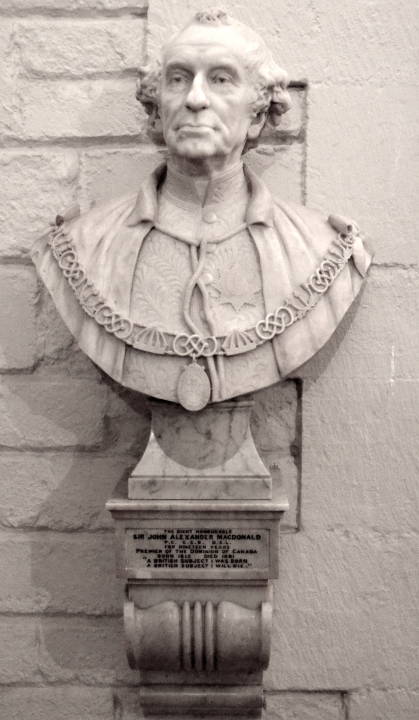
There are a ton of other greats entombed here including many great artists with J.W.M. Turner and William Blake leading the pack and I could go on at length, but it’s time to move on up.
St. Paul’s Cathedral Dome
I’ve climbed to the top of more cathedrals than my aching knees care to remember and now it’s time to tackle St Paul’s Cathedral. There are 257 steps up to the Whispering Gallery from where you can look down at the people looking up. This is a piece of cake. However there’s another almost 300 steps to get to the Golden Gallery from where you can step outside and these are a little more tricky. Luckily we seem to be the only ones trying it.
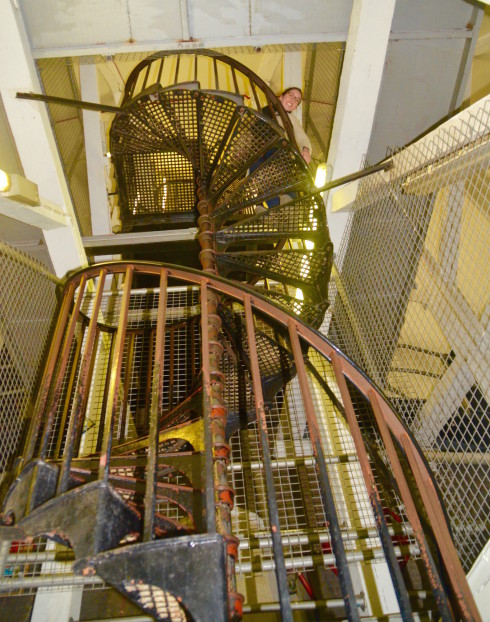
Once you get to the top the view is so stupendous that you quickly forget the effort it took to get here. I titled this post the Best View in London, because I think it is. Yes the observation tower in The Shard is higher and so is the London Eye, but they are behind glass and besides any wimp can get there. The feeling of stepping outside on to a quite narrow platform with a not so high railing is exhilarating. The wind whips your hair and makes your eyes water, but who cares. Look at this view!
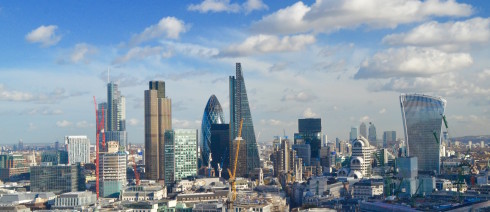
And this one!
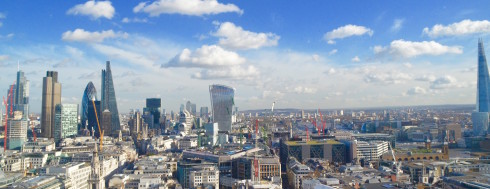
It turns out there was another couple up there as well, Germans not unsurprisingly, and we each took the others’ picture. Here’s a great father/daughter moment atop St Paul’s Cathedral. You should try it yourself.
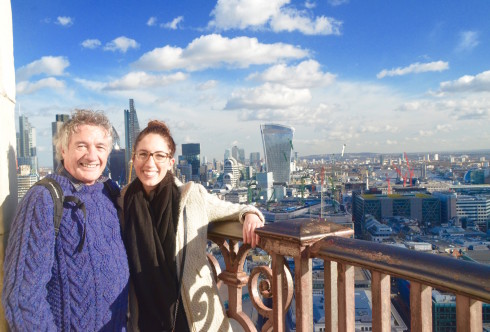
Next we’ll be visiting the Queen at Buckingham Palace (well looking at it anyway) and the Tower of London. Hope you’ll join us.

